 W
WNative American cuisine includes all cuisines and food practices of the indigenous peoples of the Americas. Contemporary Native peoples retain a varied culture of traditional foods, along with the addition of some post-contact foods that have become customary and even iconic of present-day Native American social gatherings. Foods like cornbread, turkey, cranberry, blueberry, hominy and mush have been adopted into the cuisine of the broader United States population from Native American cultures.
 W
WAlaskan ice cream is a dessert made of dried fish, dried moose or caribou meat and fat and berries or mild sweeteners such as roots of Indian potato or wild carrot, mixed and whipped with a whisk or formerly hand made by Alaskan Athabaskans. Traditionally, it was made with whipped fat mixed with berries like cranberries, salmonberries, crowberries, cloudberries, and blueberries, fish, tundra greens, or roots with animal oil or fat. It may also include whitefish, caribou tallow, moose tallow, walrus tallow, or seal oil. There is also a kind of akutaq which is called snow akutaq. The most common recipes for Indian ice cream consist of dried and pulverized moose or caribou tenderloin that is blended with moose fat until the mixture is light and fluffy. It may be eaten unfrozen or frozen, and in the latter case it somewhat resembles commercial ice cream.
 W
WThe American chestnut is a large deciduous tree of the beech family native to eastern North America. The American chestnut was one of the most important forest trees throughout its range and was considered the finest chestnut tree in the world.
 W
WAztec cuisine is the cuisine of the former Aztec Empire and the Nahua peoples of the Valley of Mexico prior to European contact in 1519.
 W
WBannock is a variety of flat quick bread or any large, round article baked or cooked from grain. A bannock is usually cut into sections before serving.
 W
WThe bighorn sheep is a species of sheep native to North America. It is named for its large horns. A pair of horns might weigh up to 14 kg (30 lb); the sheep typically weigh up to 143 kg (315 lb). Recent genetic testing indicates three distinct subspecies of Ovis canadensis, one of which is endangered: O. c. sierrae. Sheep originally crossed to North America over the Bering Land Bridge from Siberia; the population in North America peaked in the millions, and the bighorn sheep entered into the mythology of Native Americans. By 1900, the population had crashed to several thousand, due to diseases introduced through European livestock and overhunting.
 W
WThe American bison or simply bison, also commonly known as the American buffalo or simply buffalo, is an American species of bison that once roamed North America in vast herds. Its historical range, by 9000 BC, is described as the great bison belt, a tract of rich grassland that ran from Alaska to the Gulf of Mexico, east to the Atlantic Seaboard as far north as New York and south to Georgia and, according to some sources, down to Florida, with sightings in North Carolina near Buffalo Ford on the Catawba River as late as 1750. It nearly became extinct by a combination of commercial hunting and slaughter in the 19th century and introduction of bovine diseases from domestic cattle. With a population in excess of 60 million in the late 18th century, the species was down to just 541 animals by 1889. Recovery efforts expanded in the mid-20th century, with a resurgence to roughly 31,000 wild bison today, largely restricted to a few national parks and reserves. Through multiple reintroductions, the species is now also freely roaming wild in some regions in the United States, Canada, and Mexico, with it also being introduced to Yakutia in Russia.
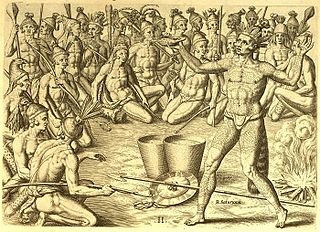 W
WBlack drink is a name for several kinds of ritual beverages brewed by Native Americans in the Southeastern United States. Traditional ceremonial people of the Yuchi, Caddo, Chickasaw, Cherokee, Choctaw, Muscogee and some other Indigenous peoples of the Southeastern Woodlands use the black drink in purification ceremonies. It was occasionally known as white drink because of the association of the color white with peace leaders in some Native cultures in the Southeast.
 W
WCalathea allouia, known as lerén or lairén in Spanish, and also known in English as Guinea arrowroot, and sweet corn root, is a plant in the arrowroot family, native to northern South America and the Caribbean, The name "allouia" is derived from the Carib name for the plant Leren is a minor food crop in the American tropics, but was one of the earliest plants domesticated by pre-historic Amerindians in South America.
 W
WChicha is a fermented (alcoholic) or non-fermented beverage of Latin America, emerging from the Andes and Amazonia regions. In both the pre- and post-Spanish conquest periods, corn beer made from a variety of maize landraces has been the most common form of chicha. However, chicha is also made from a variety of other cultigens and wild plants, including, among others, quinoa, kañiwa, peanut, manioc, palm fruit, potato, oca, and chañar. There are many regional variations of chicha. In the Inca Empire, chicha had ceremonial and ritual uses.
 W
WChuño is a freeze-dried potato product traditionally made by Quechua and Aymara communities of Bolivia and Peru, and is known in various countries of South America, including Argentina, Bolivia, Chile and Peru. It is a five-day process, obtained by exposing a bitter, frost-resistant variety of potatoes to the very low night temperatures of the Andean Altiplano, freezing them, and subsequently exposing them to the intense sunlight of the day. The word comes from Quechua ch'uñu, meaning 'frozen potato'.
 W
WCorn on the cob is a culinary term used for a cooked ear of freshly picked maize from a cultivar of sweet corn. Sweet corn is the most common variety of maize eaten directly off the cob. The ear is picked while the endosperm is in the "milk stage" so that the kernels are still tender. Ears of corn are steamed or boiled, usually without their green husks, or roasted with them. The husk leaves are in any case removed before serving.
 W
WCorn soup is a soup made of corn, typically sweetcorn. Initially popular only in corn-producing areas of the world, the dish is now widespread because of greater corn distribution. Typical ingredients are corn cut from the cob, water, butter and flour, with salt and pepper for seasoning. Additional ingredients vary by region, and may include eggs.
 W
WCreamed corn is a type of creamed food made by combining pieces of whole sweetcorn with a soup of milky residue from pulped corn kernels scraped from the cob. Originating in Native American cuisine, it is now most commonly eaten in the Midwestern and Southern United States as well as the Canadian province of Quebec, where it is notably used in pâté chinois. It is an almost soupy version of sweetcorn, but unlike other preparations of sweetcorn, creamed corn is partially puréed, releasing the liquid contents of the kernels.
 W
WCucurbita is a genus of herbaceous vines in the gourd family, Cucurbitaceae native to the Andes and Mesoamerica. Five species are grown worldwide for their edible fruit, variously known as squash, pumpkin, or gourd, depending on species, variety, and local parlance, and for their seeds. Other kinds of gourd, also called bottle-gourds, are native to Africa and belong to the genus Lagenaria, which is in the same family and subfamily as Cucurbita, but in a different tribe. These other gourds are used as utensils or vessels, and their young fruits are eaten much like those of Cucurbita species.
 W
WFilé powder, also called gumbo filé, is a spicy herb made from the dried and ground leaves of the North American sassafras tree (Sassafras albidum).
 W
WFrybread is a flat dough bread, fried or deep-fried in oil, shortening, or lard. Made with simple ingredients, generally wheat flour, sugar, salt, and fat, frybread can be eaten alone or with various toppings such as honey, jam, powdered sugar, venison, or beef. Frybread can also be made into tacos, like Navajo tacos.
 W
WGrits are a porridge made from boiled cornmeal. Hominy grits are a type of grits made from hominy – corn that has been treated with an alkali in a process called nixtamalization, with the pericarp removed. Grits are often served with other flavorings as a breakfast dish. Grits can be either savory or sweet, with savory seasonings being more common. The dish originated in the Southern United States but is now available nationwide. Grits are popular as the dinner entrée shrimp and grits, served primarily in the South. Grits should not be confused with boiled ground corn, hasty pudding, mush, or polenta, as these have differing ingredients.
 W
WPepperpot is an Amerindian-derived dish popular in Guyana. It is traditionally served at Christmas and other special events. Along with chicken curry, and cook-up rice, pepperpot is one of Guyana's national dishes.
 W
WA Hog Fry is a traditional Oklahoma Cherokee social meal in which large iron kettles are placed over open fires. The kettles are then filled with oil or lard. Pieces of pork are then thrown in the hot oil and fried until cooked.
 W
WHominy is a food produced from dried maize (corn) kernels that have been treated with an alkali, in a process called nixtamalization. "Lye hominy" is a type of hominy made with lye.
 W
WHumita is a Native South American dish from pre-Hispanic times, and a traditional food mostly from the Andean region of Ecuador. It is also somewhat traditional in Bolivia, Chile, Peru and Northwest Argentina. It consists of masa harina and corn, wrapped in a corn husk, and slowly steamed or boiled in a pot of water. It is similar to a tamale, but made with fresh ground corn. In Bolivia it is known as huminta and in Brazil as pamonha.
 W
WIndirect grilling is a barbecue cooking technique in which the food is placed to the side of or above the heat source instead of directly over the flame as is more common. This can be achieved by igniting only some burners on a gas barbecue or by piling coals to one side of a charcoal pit. A drip tray is placed below the food to prevent fat from the food igniting and generating a direct flame. Indirect grilling is designed to cook larger or tougher foods that would burn if cooked using a direct flame. This method of cooking generates a more moderate temperature and allows for an easier introduction of wood smoke for flavoring.
 W
WA mano is a ground stone tool used with a metate to process or grind food by hand. It is also known by the Nahuatl term metlapil.
 W
WMaque choux is a traditional dish of Louisiana. It is thought to be an amalgam of Creole and American Indian cultural influence, and the name is likely to derive from the French interpretation of the Native American name.
 W
WMaranta arundinacea, also known as arrowroot, maranta, West Indian arrowroot, obedience plant, Bermuda arrowroot, araru, araruta, ararao or hulankeeriya, is a large, perennial herb found in rainforest habitats. Arrowroot flour is now produced commercially mostly in St. Vincent and the Grenadines. Arrowroot was one of the earliest plants to be domesticated for food in northern South America, with evidence of exploitation or cultivation of the plant dating back to 8200 BC.
 W
WMashed pumpkin is a vegetable dish made by cooking or macerating the skinless flesh (pulp) of pumpkins and then mashing, straining, grinding, or puréeing until the desired consistency is achieved. It is traditionally served as a side dish, although it has many uses in cooking and baking.
 W
WAncient Maya cuisine was varied and extensive. Many different types of resources were consumed, including maritime, flora, and faunal material, and food was obtained or produced through strategies such as hunting, foraging, and large-scale agricultural production. Plant domestication concentrated upon several core foods, the most important of which was maize.
 W
WMazamorra is the name for numerous traditional dishes from Iberian Peninsula and Latin America.
 W
WMesquite flour is made from the dried and ground pods of the mesquite, a tree that grows throughout Mexico and the southwestern US in arid and drought-prone climates. The flour made from the long, beige-colored seedpods has a sweet, slightly nutty flavor and can be used in a wide variety of applications. It has a high-protein, low-glycemic content and can serve as a gluten-free replacement for flours that contain gluten.
 W
WMote is the generic name for several varieties of corn grains boiled, consumed in many regions of South America. It is usually prepared by boiling the grains in water made alkaline by the addition of ashes or lime, a process known as nixtamalization.
 W
WThe mountain goat, also known as the Rocky Mountain goat, is a hoofed mammal endemic to North America. A subalpine to alpine species, it is a sure-footed climber commonly seen on cliffs and ice.
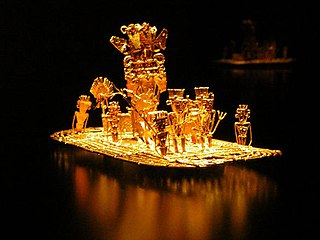 W
WMuisca cuisine describes the food and preparation the Muisca elaborated. The Muisca were an advanced civilization inhabiting the central highlands of the Colombian Andes before the Spanish conquest of the Muisca in the 1530s. Their diet and cuisine consisted of many endemic flora and fauna of Colombia.
 W
WNettle soup is a traditional soup prepared from stinging nettles. Nettle soup is eaten mainly during spring and early summer, when young nettle buds are collected. Today, nettle soup is mostly eaten in Scandinavia, Iran, Ireland, and Eastern Europe, with regional differences in recipe; however historically consumption of nettles was more widespread.
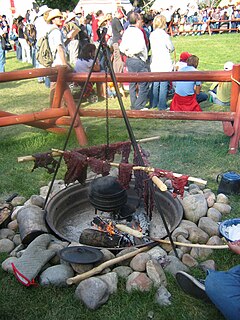 W
WPânsâwân, or dry meat, is a type of dried smoked meat product made by the indigenous peoples of Canada including the Cree, Dene, and Métis. The term is loosely translated from the Cree language as "thin-sliced meat" with the meat used for its production from bison, elk, or moose. It is commonly made in the indigenous community, considered a delicacy, and is also culturally significant.
 W
WPashofa, or pishofa, is a Chickasaw and Choctaw Indian soupy dish made from cracked white corn, also known as pearl hominy. The dish is one of the most important to the Chickasaw people and has been served at ceremonial and social events for centuries. Pashofa is also used in specific healing ceremonies.
 W
WPemmican is a mixture of tallow, dried meat, and dried berries that is used as a nutritious food. Historically, it was an important part of indigenous cuisine in certain parts of North America and it is still prepared today. The word comes from the Cree word pimîhkân, which is derived from the word pimî, "fat, grease". The Lakota word is wasná, originally meaning "grease derived from marrow bones", with the wa- creating a noun, and sná referring to small pieces that adhere to something. It was invented by the Indigenous peoples of North America.
 W
WMagicicada is the genus of the 13-year and 17-year periodical cicadas of eastern North America, consisting of seven species. Although they are sometimes called "locusts", this is a misnomer, as cicadas belong to the taxonomic order Hemiptera, suborder Auchenorrhyncha, while locusts are grasshoppers belonging to the order Orthoptera. Magicicada belongs to the cicada tribe Lamotialnini, a group of genera with representatives in Australia, Africa, and Asia, as well as the Americas.
 W
WPhyla dulcis is a species of perennial herb that is native to southern Mexico, the Caribbean, Central America, Colombia, and Venezuela. It is known by several common names, including Aztec sweet herb, bushy lippia, honeyherb, hierba dulce, and tzopelic-xihuitl (Nahuatl). Its buds are also sold as dushi or dulce buttons.
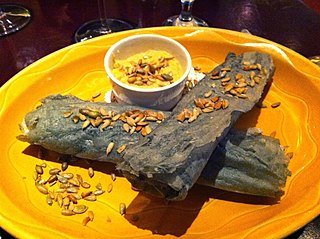 W
WPiki is a bread made from blue corn meal used in Hopi cuisine.
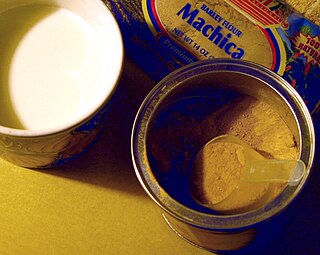 W
WPinole, also called pinol or pinolillo, is roasted ground maize, which is then mixed with a combination of cocoa, agave, cinnamon, chia seeds, vanilla, or other spices. The resulting powder is then used as a nutrient-dense ingredient to make different foods, such as cereals, baked goods, tortillas, and beverages. The name comes from the Nahuatl word pinolli, meaning cornmeal. Today, pinole is generally made by hand using wood-burning adobe ovens and a stone and pestle, and is still consumed in certain, often rural, parts of Latin America. Pinole is considered the national beverage of Nicaragua and Honduras.
 W
WPit barbecue is a method and/or apparatus for barbecue cooking meat and root vegetables buried below ground. Indigenous peoples around the world used earth ovens for thousands of years. In modern times the term and activity is often associated with the Eastern Seaboard, the "barbecue belt", colonial California in the United States and Mexico. The meats usually barbecued in a pit in these contexts are beef, pork, and goat.
 W
WPone is a type of baked or fried bread in American cuisine, and the Cuisine of the Southern United States. Pone could be made with corn, or some other main ingredient could be used like sweet potato. This style of bread, eaten cold as a breakfast food, was a staple food of the cuisine of the Thirteen Colonies.
 W
WPopcorn is a variety of corn kernel which expands and puffs up when heated; the same names are also used to refer to the foodstuff produced by the expansion.
 W
WPre-Columbian cuisine refers to the food and drink consumed by the people who inhabited the Americas before Christopher Columbus explored the region and introduced food and crops from Europe. Though the Columbian Exchange introduced many new animals and plants to the Americas, cultures of their own already existed there, including the Aztec, Mayan, Incan, and Native American. The development of agriculture allowed the many different cultures to transition from hunting to staying in one place. A major element of this cuisine is maize, which began being grown in central Mexico. Other crops that flourished in the Americas include amaranth, wild rice, and lima beans.
 W
WRubaboo is a common stew or porridge consumed by coureurs des bois and voyageurs and Métis people of North America. This dish is traditionally made of peas and/ or corn, with grease and a thickening agent that makes up the base of the stew. Pemmican and maple sugar were also commonly added to the mixture. Rubaboo that is made by the Plains Metis is often made with pemmican, rabbit, prairie chicken or sage hen and a wide variety of wild vegetables such as wild parsnip onion, turnip, and asparagus that can all be added to the food with preference. The thickened mixture was later re-served as “rowschow” (re-chaud). Sometimes, It is occasionally spelled Rubbaboo. Other sources describe it as consisting primarily of boiled pemmican, with thickening agents added when available.
 W
WThe Sioux Chef's Indigenous Kitchen is a recipe book written by Sean Sherman with Beth Dooley, published by the University of MN Press in Minneapolis, Minnesota. Sean Sherman is an Oglala Lakota chef who was born in Pine Ridge, South Dakota and is currently based in South Minneapolis. Sherman will be opening an indigenous cuisine restaurant within the Water Works park development project overlooking Saint Anthony Falls and the Stone Arch Bridge in Minneapolis, due to open in 2019.
 W
WSuccotash is a culinary dish consisting primarily of sweet corn with lima beans or other shell beans. Other ingredients may be added including corned beef, potatoes, turnips, salt pork, tomatoes, multi-colored sweet peppers, and okra. Combining a grain with a legume provides a dish that is high in all essential amino acids.
 W
WThe food of the Tlingit people, an indigenous people from Alaska, British Columbia, and the Yukon, is a central part of Tlingit culture, and the land is an abundant provider. A saying amongst the Tlingit is that "When the tide goes out the table is set." This refers to the richness of intertidal life found on the beaches of Southeast Alaska, most of which can be harvested for food. Another saying is that "in Lingít Aaní you have to be an idiot to starve". Since food is so easy to gather from the beaches, a person who can't feed himself at least enough to stay alive is considered a fool, perhaps mentally incompetent or suffering from very bad luck. Though eating off the beach could provide a fairly healthy and varied diet, eating nothing but "beach food" is considered contemptible among the Tlingit, and a sign of poverty. Shamans and their families were required to abstain from all food gathered from the beach, and men might avoid eating beach food before battles or strenuous activities in the belief that it would weaken them spiritually and perhaps physically as well. Thus for both spiritual reasons as well as to add some variety to the diet, the Tlingit harvest many other resources for food besides what they easily find outside their front doors. No other food resource receives as much emphasis as salmon; however, seal and game are both close seconds.
 W
WTurkey meat, commonly referred to as just turkey, is the meat from turkeys, typically domesticated turkeys but also wild turkeys. It is a popular poultry dish, especially in North America, where it is traditionally consumed as part of culturally significant events such as Thanksgiving and Christmas, as well as in standard cuisine.
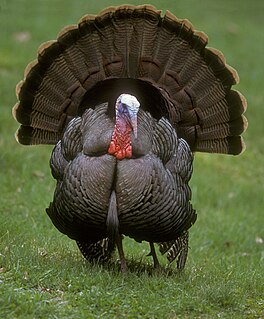 W
WThe wild turkey is an upland ground bird native to North America, one of two extant species of turkey, and the heaviest member of the order Galliformes. It is the ancestor to the domestic turkey, which was originally derived from a southern Mexican subspecies of wild turkey. Although native to North America, the turkey probably got its name from the domesticated variety being imported to Britain in ships coming from the Levant via Spain. The British at the time therefore associated the wild turkey with the country Turkey and the name prevails. An alternative theory posits that another bird, a guinea fowl native to Madagascar introduced to England by Turkish merchants, was the original source, and that the term was then transferred to the New World bird by English colonizers with knowledge of the previous species.
 W
WWhale meat, broadly speaking, may include all cetaceans and all parts of the animal: muscle (meat), organs (offal), skin (muktuk), and fat (blubber). There is relatively little demand for it, compared to farmed livestock, and commercial whaling, which has faced opposition for decades, continues today in very few countries, although whale meat used to be eaten across Western Europe and colonial America. However, wherever dolphin drive hunting and aboriginal whaling exist, marine mammals are eaten locally as part of the subsistence economy: in the Faroe Islands, in the circumpolar Arctic, other indigenous peoples of the United States, in St. Vincent and the Grenadines, in a couple of villages in Indonesia and in certain South Pacific islands.